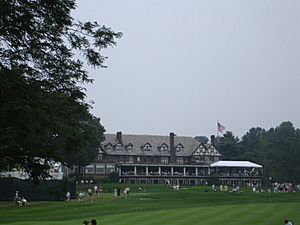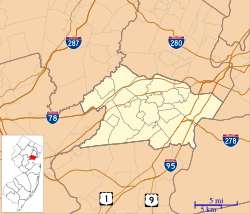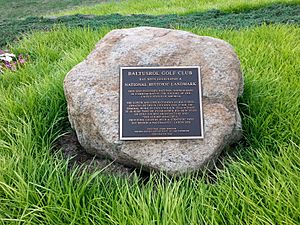Baltusrol Golf Club facts for kids

Clubhouse during the 2005 PGA Championship
|
|
| Club information | |
|---|---|
| Lua error in Module:Location_map at line 420: attempt to index field 'wikibase' (a nil value). | |
| Location | Springfield, New Jersey |
| Established | 1895, 130 years ago |
| Type | Private |
| Total holes | 36 |
| Tournaments hosted |
List of Major Tournaments
PGA Championship (2005, 2016)
U.S. Open (1903, 1915, 1936, 1954, 1967, 1980, 1993) U.S. Women's Open (1961, 1985) U.S. Amateur (1904, 1926, 1946, 2000) U.S. Women's Amateur (1901, 1911) KPMG Women's PGA Championship (2023) |
| Greens | Bentgrass / Poa annua |
| Fairways | Bentgrass / Poa annua |
| Lower Course | |
| Designed by | A. W. Tillinghast (1922), Gil Hanse & Jim Wagner(2021 renovation) |
| Par | 72 (70 for majors) |
| Length | 7,550 yards (6,904 m) |
| Course rating | 76.2 |
| Slope rating | 145 |
| Upper Course | |
| Designed by | A. W. Tillinghast Gil Hanse & Jim Wagner (2023-2024 renovation) |
| Par | 72 |
| Length | 7,348 yards (6,719 m) |
| Course rating | 75.9 |
| Slope rating | 151 |
|
Baltusrol Golf Club
|
|
| Location | 201 Shunpike Road, Springfield, New Jersey |
| Area | 474 acres (192 ha) |
| Built | 1909: Clubhouse 1918–26: Courses |
| Architect | Clubhouse: Chester H. Kirk Courses: A. W. Tillinghast |
| Architectural style | Tudor Revival |
| NRHP reference No. | 05000374 |
| Significant dates | |
| Added to NRHP | May 6, 2005 |
| Designated NHLD | August 25, 2014 |
The Baltusrol Golf Club is a special private golf club in Springfield, New Jersey. It's about 20 miles (32 km) west of New York City. This club has 36 holes for playing golf.
It was started in 1895 by a person named Louis Keller. Baltusrol made history in 1985. It was the first club ever to host both the U.S. Open and the U.S. Women's Open golf tournaments on two different courses!
The famous golf course designer A. W. Tillinghast created both of Baltusrol's main courses in 1918. Over the years, the club has hosted seven U.S. Opens and two PGA Championships. In 2005, Baltusrol Golf Club was added to the National Register of Historic Places. Later, in 2014, it became a National Historic Landmark. This shows how important its golf course design is.
Contents
History of Baltusrol Golf Club
The club gets its name from Baltus Roll (1769–1831). He was a farmer who owned the land where the club is today. Sadly, he was murdered in 1831 by thieves.
In the 1890s, Louis Keller bought the land. He was famous for publishing the New York Social Register. Keller owned a large area of land in Springfield Township. On October 19, 1895, he announced that the Baltusrol Golf Club would open.
The club first had a 9-hole course, designed by George Hunter in 1895. It grew to 18 holes by 1898. This first course was called the Old Course.
Designing the Dual Courses
Louis Keller later hired A. W. Tillinghast to build another golf course. But Tillinghast had a different idea. He suggested plowing over the Old Course and building two brand new courses instead! The club agreed with his plan.
Construction of the new Upper and Lower courses began in 1918. In 1919, a golf magazine said that Baltusrol's plans were "vaster" than anything tried before in American golf. These "Dual Courses" were the first 36-hole design built side-by-side in America.
Both the Upper and Lower courses officially opened in June 1922. After they opened, some changes were made to get them ready for big national championships. The first major event on the Lower Course was the 1926 U.S. Amateur. The Upper Course hosted its first national championship, the U.S. Open, in 1936. Tillinghast continued to be the club's architect until he passed away in 1942.
Course Updates and Famous Winners
In 1948, Robert Trent Jones was hired to update the Lower Course for tournaments. His son, Rees Jones, made the Lower Course even longer in 1992 for the 1993 U.S. Open. He also updated the Upper Course for the 2000 U.S. Amateur.
Both Jones and his designer, Steve Weisser, brought back many of Tillinghast's original design ideas that had been changed over time. Many famous golfers have won tournaments at Baltusrol. These include Ed Furgol, Mickey Wright, Jack Nicklaus, Lee Janzen, and Phil Mickelson. In 1995, Golf Magazine named Baltusrol one of "The First 100 Clubs in America."
The Clubhouse
In March 1909, the original clubhouse at Baltusrol burned down. But a new one was quickly designed that same year by Chester Hugh Kirk, who was a member of the club. It was built in a beautiful Tudor revival style.
In 1912, this new clubhouse became the first golf clubhouse ever to host a President of the United States, William Howard Taft.
Major Golf Tournaments Hosted
Baltusrol has hosted many important golf championships. It has been the site for 15 championships sponsored by the USGA and three by the PGA.
It has hosted the U.S. Open seven times: in 1903, 1915, 1936, 1954, 1967, 1980, and 1993. The club has also hosted the U.S. Amateur four times (1904, 1926, 1946, 2000).
The U.S. Women's Open has been held here twice (1961, 1985). The U.S. Women's Amateur was also hosted twice (1901, 1911). Baltusrol hosted its first PGA Championship in 2005 and again in 2016. The club also hosted the 2023 Women's PGA Championship.
| Year | Tournament | Course | Winner |
|---|---|---|---|
| 2023 | Women's PGA Championship | Lower Course | |
| 2018 | U.S. Junior Amateur | Medal play – Both Match play – Upper |
|
| 2016 | PGA Championship | Lower Course | |
| 2005 | PGA Championship | Lower Course | |
| 2000 | U.S. Amateur | Medal play – Both Match play – Upper |
|
| 1993 | U.S. Open | Lower Course | |
| 1985 | U.S. Women's Open | Upper Course | |
| 1980 | U.S. Open | Lower Course | |
| 1967 | U.S. Open | Lower Course | |
| 1961 | U.S. Women's Open | Lower Course | |
| 1954 | U.S. Open | Lower Course | |
| 1946 | U.S. Amateur | Lower Course | |
| 1936 | U.S. Open | Upper Course | |
| 1926 | U.S. Amateur | Lower Course | |
| 1915 | U.S. Open | Old Course | |
| 1911 | U.S. Women's Amateur | Old Course | |
| 1904 | U.S. Amateur | Old Course | |
| 1903 | U.S. Open | Old Course | |
| 1901 | U.S. Women's Amateur | Old Course |
About the Golf Courses
The Upper and Lower courses at Baltusrol are quite different. They were built on two unique types of land. Tillinghast designed them to be "Dual Courses," meaning golfers would enjoy playing either one.
The Lower Course is on rolling parkland. This land was shaped by a glacier about 18,000 years ago. The Upper Course runs along a ridge called Baltusrol Mountain. This mountain was formed by ancient lava flows about 200 million years ago.
Both courses have ponds and other challenges for golfers. On the Lower Course, holes 4 and 18 have ponds. On the Upper Course, holes 9 and 13 have ponds. Creeks also come into play on holes 10, 13, and 15. Baltusrol is the only club with two courses that has hosted both the U.S. Men's and Women's Open Championships on both of its courses.
Lower Course Highlights
The Lower Course is a par 72 course. From the longest tees (black tees), it measures about 7,400 yards (6,767 m). For the 2005 PGA Championship, it was set up as a par 70 course, measuring 7,392 yards (6,759 m).
Golf Magazine has often ranked the Lower Course as one of the "Top 100 Courses in the U.S." It was ranked 22nd in 1995, 1997, and 1999.
Some famous holes on the Lower Course include:
- The fourth hole: A par three where you hit the ball over a pond to a green with two levels.
- The seventeenth hole: A long par five, about 650 yards (594 m). John Daly is the only player known to reach the green in just two shots!
- The eighteenth hole: A par five, about 533 yards (487 m). This hole is famous for amazing finishes by golfers like Furgol, Nicklaus, Mickelson, and Jason Day.
| Tee | Rating/Slope | 1 | 2 | 3 | 4 | 5 | 6 | 7 | 8 | 9 | Out | 10 | 11 | 12 | 13 | 14 | 15 | 16 | 17 | 18 | In | Total |
|---|---|---|---|---|---|---|---|---|---|---|---|---|---|---|---|---|---|---|---|---|---|---|
| Par | 5 | 4 | 4 | 3 | 4 | 4 | 5 | 4 | 3 | 36 | 4 | 4 | 3 | 4 | 4 | 4 | 3 | 5 | 5 | 36 | 72 | |
| Championship | 76 / 147 | 478 | 378 | 503 | 199 | 424 | 482 | 503 | 374 | 211 | 3,552 | 464 | 444 | 219 | 432 | 430 | 429 | 230 | 647 | 553 | 3,848 | 7,400 |
| Tillinghast | 74.4 / 143 | 478 | 371 | 451 | 186 | 395 | 465 | 500 | 374 | 205 | 3,425 | 444 | 422 | 202 | 401 | 406 | 415 | 210 | 570 | 520 | 3,590 | 7,015 |
| Baltusrol | 72.8 / 140 | 470 | 362 | 436 | 143 | 375 | 420 | 494 | 360 | 189 | 3,249 | 437 | 408 | 188 | 374 | 379 | 383 | 180 | 543 | 511 | 3,403 | 6,652 |
| Club | 71.4 / 135 | 456 | 350 | 405 | 130 | 352 | 408 | 465 | 350 | 175 | 3,091 | 416 | 397 | 155 | 364 | 370 | 370 | 160 | 525 | 477 | 3,234 | 6,325 |
| Handicap | 11 | 7 | 1 | 17 | 3 | 5 | 13 | 9 | 15 | 2 | 4 | 16 | 12 | 14 | 8 | 18 | 6 | 10 | ||||
| Curtis | 73.7 / 137 | 453 | 300 | 324 | 101 | 282 | 406 | 461 | 342 | 136 | 2,805 | 317 | 315 | 151 | 312 | 329 | 325 | 114 | 448 | 423 | 2,734 | 5,539 |
| Par | Curtis | 5 | 4 | 4 | 3 | 4 | 5 | 5 | 4 | 3 | 37 | 4 | 4 | 3 | 4 | 4 | 4 | 3 | 5 | 5 | 36 | 73 |
| Handicap | Curtis | 5 | 9 | 3 | 15 | 7 | 13 | 11 | 1 | 17 | 16 | 10 | 14 | 8 | 12 | 6 | 18 | 2 | 4 |
Upper Course Highlights
The Upper Course is also a par 72 course. From the black tees, it measures about 7,348 yards (6,719 m). This course has hosted three national championships, including the 1936 U.S. Open.
GOLF Magazine also recognized the Upper Course as one of the "Top 100 Courses in the U.S." It was ranked 89th in 1997 and 74th in 1999.
| Tee | Rating/Slope | 1 | 2 | 3 | 4 | 5 | 6 | 7 | 8 | 9 | Out | 10 | 11 | 12 | 13 | 14 | 15 | 16 | 17 | 18 | In | Total |
|---|---|---|---|---|---|---|---|---|---|---|---|---|---|---|---|---|---|---|---|---|---|---|
| Par | 5 | 4 | 3 | 4 | 4 | 4 | 3 | 5 | 4 | 36 | 3 | 5 | 4 | 4 | 4 | 3 | 4 | 5 | 4 | 36 | 72 | |
| Championship | 75.9 / 151 | 490 | 463 | 225 | 445 | 452 | 443 | 252 | 550 | 356 | 3,676 | 166 | 618 | 359 | 425 | 400 | 173 | 447 | 595 | 489 | 3,672 | 7,348 |
| Tillinghast | 74.7 / 147 | 485 | 433 | 193 | 412 | 423 | 423 | 225 | 541 | 345 | 3,480 | 156 | 596 | 348 | 398 | 395 | 162 | 437 | 571 | 459 | 3,522 | 7,002 |
| Baltusrol | 72.5 / 142 | 468 | 404 | 165 | 395 | 400 | 407 | 192 | 518 | 323 | 3,272 | 149 | 540 | 333 | 385 | 372 | 144 | 397 | 523 | 443 | 3,286 | 6,558 |
| Club | 70.7 / 140 | 451 | 388 | 160 | 376 | 384 | 372 | 176 | 493 | 288 | 3,088 | 138 | 540 | 313 | 342 | 362 | 134 | 374 | 511 | 430 | 3,144 | 6,232 |
| Handicap | 13 | 7 | 17 | 1 | 9 | 3 | 15 | 5 | 11 | 16 | 4 | 10 | 14 | 6 | 18 | 8 | 12 | 2 | ||||
| Curtis | 74.8 / 139 | 445 | 370 | 152 | 300 | 357 | 362 | 149 | 467 | 277 | 2,879 | 137 | 444 | 300 | 340 | 307 | 116 | 372 | 425 | 429 | 2,870 | 5,749 |
| Wright | 73.1 / 134 | 371 | 327 | 135 | 300 | 357 | 362 | 149 | 467 | 257 | 2,725 | 137 | 444 | 300 | 340 | 307 | 110 | 372 | 425 | 380 | 2,815 | 5,540 |
| Par | Curtis & Wright | 5 | 4 | 3 | 4 | 4 | 4 | 3 | 5 | 4 | 36 | 3 | 5 | 4 | 4 | 4 | 3 | 4 | 5 | 5 | 37 | 73 |
| Handicap | Curtis & Wright | 7 | 11 | 17 | 3 | 15 | 5 | 9 | 1 | 13 | 8 | 6 | 12 | 10 | 2 | 18 | 4 | 14 | 16 |
Club Rules and Course Care
The Baltusrol Golf Club is a private club, so it's not open to the public. Guests can play if they are with a member. There's a dress code: no denim (jeans), and you need to wear a collared shirt. Metal spiked shoes are not allowed. Also, you can't use cell phones on the course or club grounds, except in your car.
The course is open all year. Between 7 AM and 2 PM, players need to use a caddy. The fairways and greens are made of special grasses called poa annua and bent grass. The club takes great care of the greens.
Caring for Nature: Audubon Certification
Baltusrol Golf Club is a Certified Audubon Cooperative Sanctuary. Audubon International gave Baltusrol this award in 1999. It means the club manages its land in a way that protects the environment.
Audubon International looks at several things. These include how the club plans for the environment, manages wildlife and their homes, reduces chemical use, saves water, and keeps water clean.
See also




